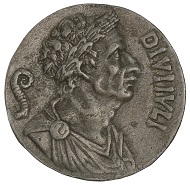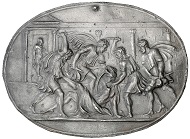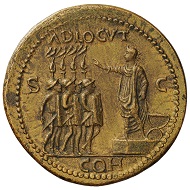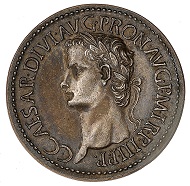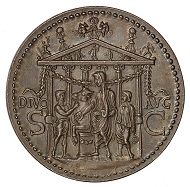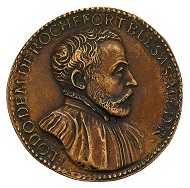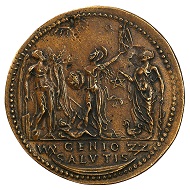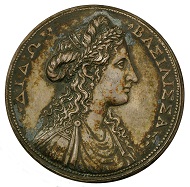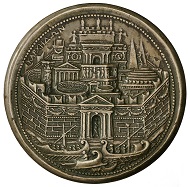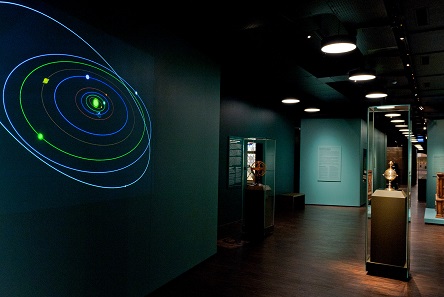January 28, 2016 – Already in the Middle Ages rulers often legitimated power by dating back their dynasty to the Roman emperors. Likewise, cities often prided themselves by tracing back their roots to the ancient past. However, from the fifteenth century onward, rulers and scholars wished for more, they strived for a “rebirth” of antiquity – a renaissance.
Fascinating antiquity
The question why the people in the Renaissance were so enthralled by antiquity is at the heart of the new special exhibition “Faked Antiquity? The Paduans and the Fascination with Antiquity” which will be on display in the Basel Barfüsser Church until May 8, 2016.
Renaissance medallion of Julius Caesar, 2nd half 15th cent., which Andrea Fulvio (c. 1470-1527) and others believed to be a true ancient piece, HMB Inv. 1905.5215.
Antiquity as perfect ideal
Antiquity was regarded as an ideal and served as a source of moral formation and virtue. The biographies and myths of classical literature were regarded as models (exempla) for Renaissance people in the process of discovering and developing their individuality. Collecting ancient objects became also a fashion that enhanced the status of their owners, allowing also citizens to distinguish themselves against the aristocracy through learning and knowledge.
Plaquette by Valerio Belli (c. 1468-1546) featuring the assassination of C. Julius Caesar (44 v. Chr.), HMB Inv. 2014.561.
Copies – better than the original?
The “rebirth of antiquity” witnessed not only the emergence of exceptional new works, people also began copying ancient works of art, often even surpassing them in artistic as well as technical respect. One of the centres that pursued the involvement with antiquity most vigorously was Padua, the Venetian University City, producing numerous works based on ancient models (all’antica). It was only later that these works were dismissed as copies, even as fakes.
“Paduan” by Giovanni da Cavino (1500-1570) copying a sesterce of Emperor Caligula (AD 37-41), with an S – C added on the reverse, one specimen overstruck on an ancient sesterce, the other struck in silver and with wrong die-link in later times, HMB Inv. 2013.766., 2011.603.1.
Giovanni da Cavino
The Padua-based goldsmith Giovanni da Cavino (1500-1570) was the first to strike pieces which perfectly resembled ancient Roman sesterces, and these so-called “Paduans” were so successful that they were copied and re-cast for centuries, which is why it is rather difficult today to recognize an original “Paduan”.
Medal of Ludovic Demoulin de Rochefort (1515-1582) by Giovanni da Cavino in the size and manner of a sesterce, HMB Inv. 2002.233.
Paduan Medals in Basel
The Historisches Museum Basel owns a unique collection of doubtlessly original “Paduans”, but also many other all’antica-medals made by Renaissance medalists, like Valerio Belli (c. 1468-1546), Nicolò Cavallerino and Alessandro Cesati. These and many other medals of that period of time belonged to the collection of the physician and antiquarian Ludovic Demoulin de Rochefort (1515-1582), who arrived in Basel after having served at the court of Savoy. He sold his exceptional collection to Basilius Amerbach (1533-1591), whose cabinet of curiosities was to form the main nucleus of Basel’s famous public collections later.
Medal by Alessandro Cesati featuring Dido of Carthage, the legendary partner of Aeneas, on the reverse with a view of Carthage, with the Column of Trajan, the Colosseum and Pantheon, HMB Inv. 1915.312.
The special exhibition in the Historisches Museum
For this the Historisches Museum Basel holds a unique collection of Renaissance all’antica medals and sculptures. The special exhibition features select objects from this source, offering visitors insight into the goals and ideals of the Renaissance age.
View of the permanent exhibition of the Historisches Museum Basel, section of Cabinet of curiosities.
The display is integrated in the permanent exhibition shown in the basement of the Barfüsser Church. Stemming from an ideal great cabinet of curiosities, this permanent exhibition illustrates how collecting evolved from the age of the Renaissance until now, still spurred by the thirst for knowledge and an interest in history, nature and art. The various topics and aspects relating to the antique copies of the Renaissance are examined in a sequence of showcases and objects highlighted with a capital “P”. The visitors are welcome to choose between booklets and tablets as exhibition guide.
Exhibition “Faked Antiquity? The Paduans and the Fascination with Antiquity”
Barfüsserplatz
Steinenberg 4
CH-4051 Basel
Opening hours
Tue – Su, 10 am – 5 pm, closed on Basel Carnival
This is the website of the Historisches Museum Basel.
Please read an article on Giovanni da Cavino published in CoinsWeekly here.
And of the CoinsWeekly series “How to detect forgeries”, this is Part 1, Part 2, Part 3, and Part 4.




